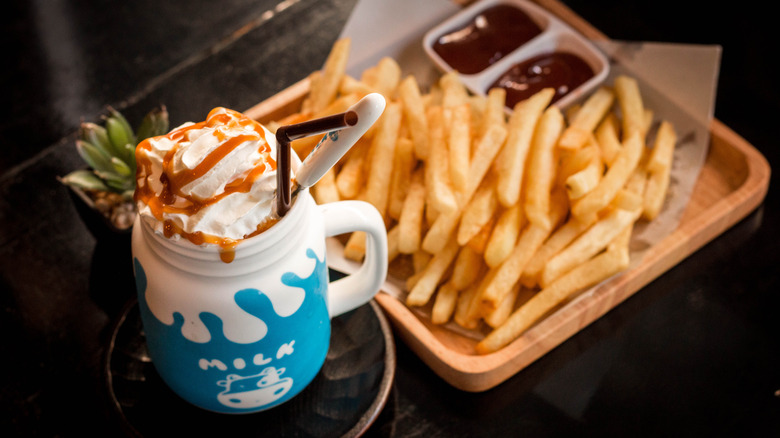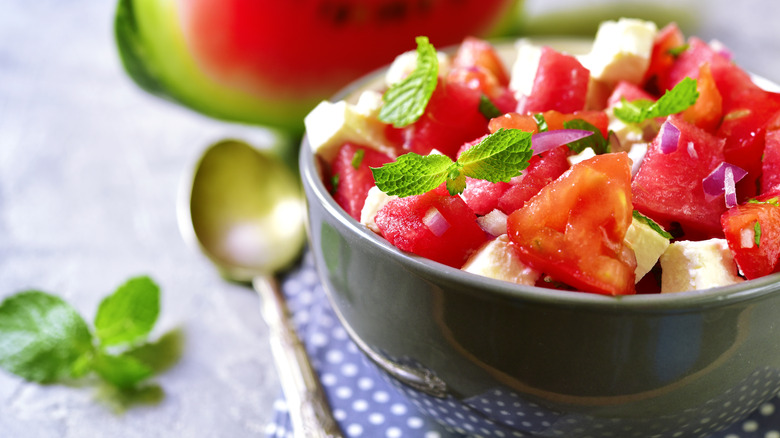There's A Scientific Reason Fries Taste So Good Dipped Into A Milkshake
Fries and milkshakes are delicious on their own, but when combined, they create an unexpectedly delightful pairing. If you've ever felt the urge to dip your hot, salty fries into a creamy, ice-cold milkshake and found yourself hooked by the contrasting temperatures, flavors, and textures, you're not alone.
The true origins of this alchemistic combo are unknown, but it has been popularized by fast-food chains like Wendy's and McDonald's. In fact, the appeal of salty-and-sweet combinations is supported by science, in what researchers call the "flavor layer effect." Historically, scientists believed that our tongues had specific sections for interpreting flavors as either salty, sweet, sour, bitter, or umami (a savory flavor). However, a 2011 study in the "Proceedings of the National Academy of Sciences" reports that a special sugar receptor on your sweet taste cells, known as sodium–glucose cotransporters (SGLT1s), activates only in the presence of sodium.
In other words, mixing salt and sugar activates SGLT1s, allowing you to perceive an extra level of sweetness layered on top of what your tongue already detects as hot and cold, salty and sweet, or crunchy and smooth. The next time you're dipping your fries into a milkshake and marveling at the delightful taste, you can thank your SGLT1s!
Why do we crave sugary and salty foods anyway?
Taste has always played an important role in human evolution, guiding us away from poisonous or non-nutritive substances (which tend to taste bitter and unpalatable) and encouraging us to consume more calorie-dense and nutritious foods (often sweet, salty, or high in fats). But why are foods high in sugar or salt (or both) so irresistibly moreish? Food cravings result from a complex combination of genetics, emotions, culture, hormones, and brain chemistry.
A 2012 study published in "Flavour and Fragrance Journal" concluded that a preference for sweetness is largely dependent on genes, and significantly influenced by the brain processes that motivate and reward us. This reward system releases dopamine and serotonin, the feel-good neurotransmitters that relieve stress and increase happiness. Some people are genetically predisposed to release more of these neurotransmitters when they taste sugar, resulting in a higher likelihood of craving these foods.
It's a misconception that food cravings are usually a sign that the body is deficient in the nutrient or food being craved. More often, cravings are driven by the brain's attempts to provide relief during stress, boredom, or other negative emotions. However, sometimes craving sugary or salty foods can be the body's way of signaling a need. For instance, a desire for salty foods might indicate a sodium deficiency and a need for the electrolytes found in salt.
Salty-sweet combos you need to try
You can sample sweet and salty dishes from multiple cultures, cuisines, and countries. For example, Thailand is renowned for tom yum goong, a broth that blends palm sugar with ultra-salty fish sauce. Canada introduced the world to Hawaiian pizza, combining the sweetness of pineapple with the saltiness of cheese and tomato sauce.
You can be adventurous in your own kitchen by pairing salty and sweet foods in your salads, snacks, or meals. Next time you make a salad, try adding salty feta and sweet watermelon, or, for a snack, consider peaches wrapped in prosciutto. To impress dinner guests, experiment with a sweet and salty chicken Marbella recipe.
If you're interested in experimenting with fast food orders, there are plenty of new combinations to try. Ordering a Frosty as a condiment for your fries is no longer the latest trend in the fast-food world! McDonald's offers an equally inventive salty-and-sweet alternative to the classic Wendy's combo. This is evidenced by TikTok user @arvanfamily, who posted a video taste-testing two McDonald's hashbrowns with a thick layer of creamy Oreo McFlurry sandwiched in between.



